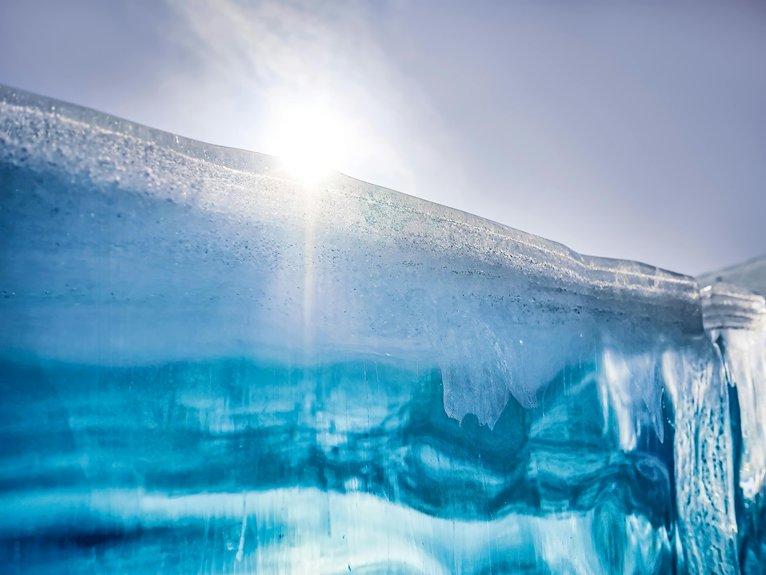The best months for diving in Larnaca are from April to November, with peak conditions from June to October. During these periods, you’ll enjoy warm water temperatures between 20°C and 28°C and excellent visibility exceeding 30 meters, ideal for exploring the Zenobia wreck and other sites. Marine life, including sea turtles and colorful nudibranchs, is vibrant during the warmer months, making these the best times for dives. Planning your dives during this season provides calm seas and clear skies, with dive operators readily available to assist.
Principales conclusiones
- The best months for diving in Larnaca are from April to November, with warm waters and clear conditions.
- The warmest period is June to October, with temperatures between 24°C and 28°C, ideal for diving.
- Visibility exceeds 30 meters during summer months, perfect for exploring sites like the Zenobia wreck.
- April to October offers water temperatures between 20°C and 30°C, ensuring comfortable diving experiences.
- The peak season, June to October, provides optimal conditions for exploring underwater wrecks and marine life.
Diving Season Overview
The best time for diving in Larnaca is from April to November, with water temperatures rising from 20°C to a warm 28°C between June and November. During these months, weather conditions are perfect, with calm seas and clear skies enhancing your diving experience. Visibility often exceeds 30 meters, especially in summer, making it ideal for exploring wrecks like the Zenobia. The stable and warm weather guarantees comfort and clarity, attracting marine life. Dive operators such as Dive-In Cyprus operate from April to November, aligning with the season. While year-round diving is possible, June to October offers the best conditions, with summer being peak season for enthusiasts seeking perfect underwater exploration opportunities.
Water Temperature and Visibility
While Larnaca’s diving season spans several months, water temperature and visibility play significant roles in determining the best times to explore its waters. The water temperature ranges from 17°C in February to 28°C in August, with the warmest period from June to November. During the peak diving season, April to October, temperatures remain between 20°C and 30°C, creating ideal conditions for divers. Visibility in Larnaca is exceptional, often exceeding 30 meters, which enhances the experience of exploring its vibrant underwater world.
| Month Range | Water Temperature (°C) | Visibility (m) |
|---|---|---|
| April–May | 20–22 | >30 |
| June–August | 24–28 | >30 |
| September–October | 22–24 | >30 |
During June to November, the warm water averages 24°C to 22°C, while visibility remains consistently clear, making these months particularly favorable for diving enthusiasts.
Main Diving Areas in Larnaca
Larnaca offers some of the most renowned diving experiences in Cyprus, headlined by the iconic Zenobia wreck, a site frequently ranked among the world’s best wreck dives. Located just offshore, this massive ferryboat lies at depths of 16 to 42 meters, offering thrilling explorations for technical and recreational divers alike. Beyond the Zenobia, Larnaca’s coast is dotted with diverse dive sites, including shallow reefs and deeper wrecks, catering to all skill levels. The region’s underwater landscape is characterized by dramatic drop-offs, vibrant marine life, and historic artifacts. Dive conditions are ideal from May to December, with warm waters and exceptional visibility, making it ideal for exploring these submerged treasures. Whether you’re exploring the intricate cargo holds of a sunken ship or gliding over colorful reefs teeming with life, Larnaca’s dive sites promise unforgettable experiences beneath the Mediterranean’s surface.
The Zenobia Wreck: A Premier Dive Site
Among the many exceptional diving opportunities Larnaca offers, the Zenobia wreck stands out as a crown jewel, drawing divers from around the globe. This 580-foot vessel lies just 10 minutes offshore, its remains resting at depths of 16 to 42 meters. The site is remarkably accessible, with no need for technical certifications, making it ideal for recreational divers. Visibility is often excellent, and the wreck teems with marine life, including groupers and moray eels, while numerous swim-throughs invite exploration. Its proximity to Larnaca port provides a quick boat ride, perfect for a day trip. Nitrox is frequently used here, allowing extended bottom time to thoroughly explore the structure. Whether you’re admiring the vibrant marine life or exploring the wreck’s vast layout, the Zenobia promises an unforgettable diving experience in the clear, azure waters of Larnaca.
Dive Packages and Costs
What makes diving in Larnaca during the best months so appealing? The combination of warm water, exceptional visibility, and diverse marine life creates an unforgettable experience. Dive packages in Larnaca cater to all levels, offering options for rookies and seasoned divers alike. Prices vary based on the type of dives, certifications, and equipment rentals, but expect to pay between €40 to €100 per dive, depending on the site and inclusions. Many operators offer discounts for multi-dive packages or group bookings, making it cost-effective for divers who plan multiple sessions. Here’s what you can expect:
- Certification and rentals: Many packages include necessary gear and guided tours, ensuring you’re well-equipped and safe.
- Local discounts: Operators often provide deals for multiple dives or longer stays, reducing costs for extended diving trips.
- Group rates: Booking as a group can lower per-person expenses, especially for larger parties.
- Instructor guidance: Packages typically include expert instructors, enhancing both safety and the quality of your dives.
- Diverse options: From wreck dives to reef explorations, packages are tailored to match your skill level and interests.
Dive packages in Larnaca are designed to maximize your underwater experience while offering value for money.
Dive Centers and Training Facilities
Visitors planning to explore Larnaca’s underwater world will find a variety of professional dive centers and training facilities equipped to meet all diving needs. These centers are staffed by certified instructors offering courses for all skill levels, from beginners to advanced divers. Many centers operate from April to November, aligning with the region’s favorable weather and sea conditions. They provide high-quality rental equipment, guided dives, and specialized training programs, ensuring a safe and enjoyable experience. Additionally, some centers offer technical diving certifications, wreck diving expeditions, and underwater photography workshops.
| Dive Center Name | Operational Months |
|---|---|
| Dive-In Cyprus | April to November |
| Larnaca Diving Center | May to December |
| Aqua Sports Diving | June to November |
| Cyprus Divers Club | Year-round (limited winter) |
| Sea Star Diving School | Summer months only |
These facilities cater to diverse needs, ensuring you’re well-prepared for Larnaca’s diving adventures.
Marine Life Encounters
Larnaca’s dive sites offer a vibrant display of marine biodiversity, particularly during the warmer months when sea temperatures peak. The crystal-clear waters teem with life, making these months a paradise for divers seeking unforgettable encounters.
- Sea turtles glide gracefully in shallow reefs, often spotted between June and October.
- Colorful nudibranchs and small marine creatures become more active, their vibrant hues contrasting against the warm, clear water.
- Groupers and larger fish species arecommonly seen in the Karpaz Peninsula during peak summer.
- Moray eels and lionfish thrive in warmer waters, especially around the Zenobia wreck.
- The diversity of species creates a dynamic ecosystem, offering divers a chance to observe marine life in its natural habitat.
These encounters highlight why Larnaca is a must-visit destination for divers seeking rich and unforgettable underwater experiences.
Tips for Planning Your Dive
While the abundance of marine life in Larnaca’s waters makes it a diver’s paradise, guaranteeing a safe and successful experience requires careful planning. Start by selecting the best diving season, typically from May to December, when warmer water conditions prevail. When diving the Zenobia wreck at 42 meters, guarantee you have the proper training or hire a reputable guide. Schedule multiple dives to fully explore the wreck, as one dive only scratches the surface. Book with experienced operators like Dive-In Cyprus for efficient access and secure diving insurance, as it’s mandatory in Cyprus.
| Consejo | Detalles | Importancia |
|---|---|---|
| Choose the right season | Plan dives May–December for warmer waters. | Guarantees ideal diving conditions. |
| Get proper training | Obtain certification or hire a guide for the Zenobia wreck. | Safeguards against deep-dive risks. |
| Secure insurance | Purchase diving insurance before your trip. | Compliance with Cypriot regulations. |
Preguntas frecuentes
When to Dive in Cyprus?
The best months for diving in Cyprus are from May to November, with water temperatures ranging from 22°C to 28°C. The diving season officially starts in March, but May offers the most favorable conditions. You’ll enjoy clear waters and excellent visibility during summer and early fall, with August being the warmest. The Zenobia wreck is accessible year-round but is best experienced during the warmer months. Plan your dives between May and November for ideal experiences.
Which Month Is Best for Scuba Diving?
For the ultimate scuba diving experience in Larnaca, you’ll find the best conditions from May to November, but August stands out as the best month with water temperatures peaking at 28°C. September and October offer excellent diving conditions with warm waters and high visibility, ideal for exploring sites like the Zenobia wreck. If you seek the hottest experience, August is perfect; otherwise, September and October provide a great balance of warmth and clarity.
Where Is the Best Diving in Cyprus?
You’re exploring diving options in Cyprus, and Larnaca stands out as a top destination due to its accessible dive sites like the Zenobia wreck, renowned for its rich marine biodiversity and underwater landscapes. The area’s clear waters and-diverse marine life make it ideal for both beginner and advanced divers. Additionally, sites like the Divemaster and the unnamed wreck offer unique experiences. Other notable spots include Limassol’s Akrotiri Peninsula, Paphos’ Amphitheatre, and Protaras’ clear waters, all providing diverse diving opportunities.
Is Cyprus Good for Scuba Diving?
You’re diving in Cyprus, where the crystal-clear Mediterranean waters offer a thrilling experience. With over 50 dive sites and visibility up to 40 meters, you’ll explore vibrant marine life, including groupers and moray eels. Cyprus is renowned for its wreck dives, like the Zenobia, ranked among the top five in the world. Dive sites cater to all levels, from the scenic reefs of Cape Greco to the challenging Chimera wreck. The calm, warm waters make navigation easy, ensuring an unforgettable dive adventure.
Conclusión
Stumbling upon Larnaca’s diving season, you’ll find yourself discovering a diver’s paradise, especially during the warmer months. The crystal-clear waters, teeming with marine life like groupers and moray eels, offer unforgettable dives, particularly at the iconic Zenobia wreck. With professional operators, your diving adventure is seamlessly planned, ensuring a safe and enriching experience. Just remember, the best dive spots are often the ones you least expect, making each plunge into Larnaca’s waters a rewarding coincidence.

Natalie lleva 10 años viviendo en Chipre. Le encanta explorar la hermosa naturaleza de la isla, como sus tranquilos bosques y sus playas vírgenes. Natalie tiene muchas experiencias interesantes que compartir. Acompáñela y cuéntenos sus aventuras en Chipre.

